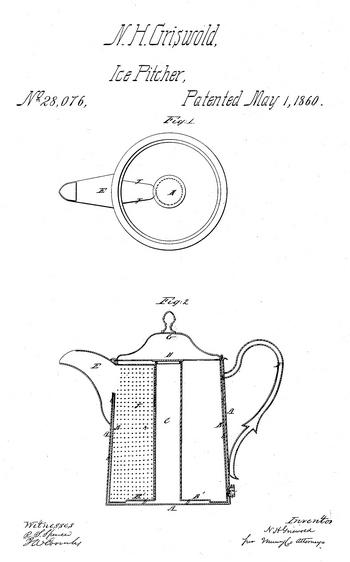Nathan Fowler Griswold
- Born: 7 Oct 1825, Lockport NY
- Marriage (1): Eliza Williams on 3 Apr 1847 in Meriden CT
General notes:
Manufacturer
Events in his life were:
- Apprenticed: POMEROY & IVES, about 1843, in Meriden CT.
- He worked circa 1850 as a pewtersmith in Queen City MO as a journeyman in the shop of GREENFIELD & WINCHELL.
- He worked circa 1852-1854 as a pewtersmith in Meriden CT for the firm of POMEROY & LEONARD.
- Partnership: George F. Searles, circa 1854, in Meriden CT. As GRISWOLD & SEARLES.
- Partnership: Henry James Lewis, circa 1855-1876, in Meriden CT. As GRISWOLD & LEWIS.

- He was issued patent number 28,076 on 1 May 1860
N. F. GRISWOLD, OF MERIDEN, CONNECTICUT.
ICE-PITCHER.
Specification of Letters Patent No. 28,076, dated May 1, 1860.
To all whom it may concern:
Be it known that I, N. F. GRISWOLD, of Meriden, in the county of New Haven and State of Connecticut, have invented a new and Improved Liquid-Refrigerating Pitcher; and I do hereby declare that the following is a full, clear, and exact description of the same, reference being had to the accompanying drawings, forming a part of this specification, in which—
Figure 1 represents a diametrical section taken through the pitcher, showing clearly the peculiarities of the same. Fig. 2, a top view of the pitcher, with the coyer removed. Similar letters of reference indicate corresponding parts in both figures.
The object of this invention and improvement in pitchers, is to be able to cool the liquid contents without bringing the ice in contact with the liquid, thus enabling me to obtain an excellent portable vessel for beer, or other like beverage, where ice would not answer to be kept in the liquid within the pitcher.
The invention further provides for retaining the cold in the pitcher and preventing a rapid wasting away of the ice. The pitcher is to be made so that to all outward appearance it will be like any ordinary pitcher. The improved attachment will not materially enhance its cost, while it will add a very desirable object to pitchers for keeping liquids cool and sweet.
To these ends my invention consists in introducing within a double wall and double bottom pitcher, a chamber, extending from the bottom to the top of the same, and communicating with the space between the walls at the bottom of the pitcher, into which chamber is placed granulated ice for cooling the surrounding contents. The pitched will be furnished with an escape hole for the water from the ice, and with a perforated strainer for pouring off the liquid clear, all as will be hereinafter described and represented.
To enable those skilled in the art to fully understand my invention, I will proceed to describe its construction and operation.
In the drawings, A represents the external wall of the pitcher, which is furnished on its side and near the bottom with an orifice that should be closed tightly, with a screw cap a. Between this wall and an interior wall B, and bottom B', is a narrow space b, that communicates with a central cylindrical chamber C, extending up to the top of the pitcher, and closed by a screw cap D. Into this chamber C, is placed small pieces of ice. The pitcher is furnished with a spout E, handle F, and a hinged cover G, which may be double if necessary, fitting down closely on the top of the pitcher.
The entire pitcher may be made of thin sheets of britannia, tin or other suitable metal, and made plain or very highly ornamental, as may be desired.
J, represents a perforated partition extending from the bottom to the top of the pitcher, placed within the inner wall, in front of the chamber C, and forming communications with the spout. This arrangement forms a strainer for the liquid, and allows only the pure liquid to be decanted, the impurities being retained within the pitcher outside of the perforated partition.
In using this pitcher the chamber C, is filled with ice, the cap screwed down and the liquid, beer perhaps, drawn into the pitcher, the cover being now closed tightly, the ice will soon cool the surrounding liquid, and as the ice slowly melts, the water will escape into the space between the bottom and side walls of the pitcher from whence it may be readily drawn off by unscrewing the cap a. The air within the space surrounding the liquid will assist to a great extent in keeping down its temperature, and thus prevent a rapid melting of the ice. The space between the double wall has another object besides serving as a non-conductor to prevent the rapid evaporation of heat, for it will be seen that a large quantity of the waste water of ice chamber C, will be conducted off into this space between the walls and so the ice will keep much longer.
This invention is gotten up with a view to the requirements of a good beer cooling Pitcher, where the beer may be cooled and ept cool for a length of time while in the pitcher. The spout E, may have a hinged cover, that will fit tightly, and which will open to allow the liquid to flow freely when the pitcher is tipped over.
Having thus described my invention, what I claim and desire to secure by Letters Patent is—
A refrigerating pitcher having double walls, and an ice chamber 0, communicating therewith, arranged in the manner substantially as herein set forth.
N. F. Griswold
Witnesses:
A. G. Foster
James Logan
- He appeared on the census in 1880 in Meriden CT. Listed as a hardware manufacturer.
Nathan married Eliza Williams on 3 Apr 1847 in Meriden CT. (Eliza Williams was born in 1828 in Meriden CT and died on 1 Aug 1868 in Meriden CT.)
|

